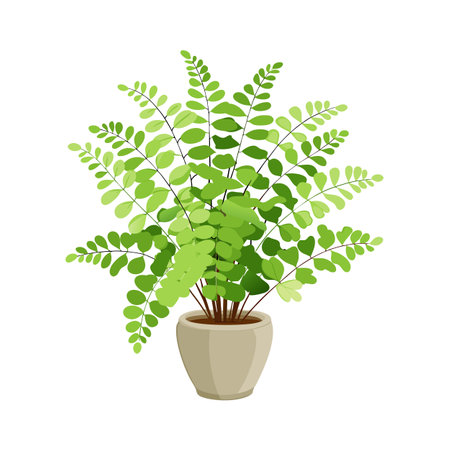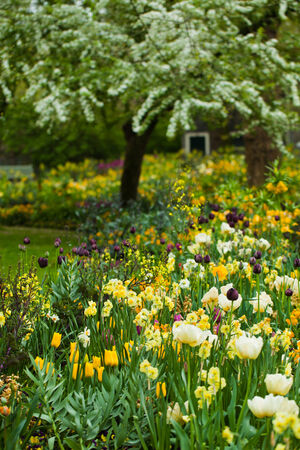Introduction to Edible Perennials and Fall Planting
When it comes to growing your own food, perennial vegetables and herbs are some of the best choices for home gardeners across the United States. Unlike annuals that need to be replanted every year, perennials come back season after season—making your garden more productive and less work in the long run. But what exactly are edible perennials, and why is fall the perfect time to plant them for a strong spring start? Let’s dig in.
What Are Edible Perennials?
Edible perennials are plants that live for more than two years and provide you with harvests year after year. These include vegetables like asparagus and rhubarb, as well as herbs such as chives and oregano. Once established, they require minimal effort compared to annual crops, making them a smart investment for any backyard gardener.
Benefits of Growing Perennial Vegetables and Herbs
| Benefit | Description |
|---|---|
| Low Maintenance | No need to replant every spring; just keep them healthy and enjoy recurring harvests. |
| Saves Money | Buy once, harvest for years—reducing yearly seed costs. |
| Soil Health | Their deep roots help improve soil structure and prevent erosion. |
| Early Harvests | Many perennials start producing early in spring, before annuals are ready. |
| Drought Tolerance | Established perennials can handle dry spells better than many annual plants. |
Why Fall Is the Best Time to Plant Perennials
Planting edible perennials in the fall gives them a big head start for next year. Cooler temperatures mean less stress on new roots, and autumn rains help settle them into their new home. By the time spring arrives, these plants will have already established strong root systems, leading to earlier growth and bigger harvests. Plus, fall planting frees up your busy spring gardening schedule—win-win!
2. Top Edible Perennials to Plant in Fall
Planting perennial crops in the fall gives them a chance to establish roots and get a strong start come spring. Here are some of the most popular and reliable edible perennials that thrive across different American climates, along with tips on how you can enjoy them in your kitchen.
Asparagus
Asparagus is a classic perennial vegetable that’s hardy in many U.S. regions. It takes patience—usually two to three years before you harvest spears—but once established, a patch can produce for 15 years or more. Asparagus prefers full sun and well-drained soil. Enjoy it roasted, grilled, steamed, or tossed into salads and omelets.
Rhubarb
Rhubarb is famous for its tart stalks, which are perfect for pies, crisps, and jams. This cool-season perennial does best in areas with cold winters and is hardy in USDA zones 3-8. Only eat the stalks—the leaves are toxic. Rhubarb adds unique flavor to both sweet and savory dishes.
Chives
Chives are one of the easiest perennials to grow and can handle a wide range of climates. Their mild onion flavor makes them perfect for sprinkling over baked potatoes, mixing into cream cheese spreads, or garnishing soups and salads. The pretty purple flowers are also edible!
Other Edible Perennials Worth Considering
| Perennial Crop | Best Regions | Culinary Uses |
|---|---|---|
| Jerusalem Artichoke (Sunchoke) | Northern & Central U.S. | Roasted, mashed, soups |
| Sorrel | Northeast, Midwest, Pacific Northwest | Add to salads, soups, sauces for tangy flavor |
| Walking Onion (Egyptian Onion) | Most U.S. climates | Mild onion taste for salsas, salads, stir-fries |
| Horseradish | Northern & central regions | Zesty root grated into sauces and condiments |
| Good King Henry | Northeast, Midwest | Cooked greens similar to spinach; young shoots as asparagus substitute |
Quick Tips for Fall Planting Success:
- Select disease-free crowns or divisions from reputable nurseries.
- Prepare garden beds by removing weeds and amending soil with compost.
- Water newly planted perennials well to help them settle in before winter frost.
- Add a layer of mulch to protect roots through colder months.

3. Site Selection and Soil Preparation
Getting your edible perennials off to a great start in spring begins with choosing the right spot and prepping your soil in the fall. Here’s how you can set up your garden for long-lasting success:
Picking the Perfect Location
Most edible perennials, like asparagus, rhubarb, and berries, thrive when they have plenty of sunlight and good air circulation. Before you start planting, walk around your yard at different times of the day to see which areas get at least 6–8 hours of direct sunlight—this is key for healthy growth and big harvests.
| Perennial | Sunlight Needs |
|---|---|
| Asparagus | Full Sun (6–8 hours) |
| Rhubarb | Full Sun to Partial Shade |
| Blueberries | Full Sun |
| Chives | Full Sun to Partial Shade |
Soil Drainage: Don’t Let Roots Rot!
Good drainage is crucial because perennial roots hate soggy conditions. To check your site’s drainage, dig a hole about a foot deep and fill it with water. If it drains within 24 hours, you’re good to go. Still soggy? Consider raised beds or mounding up soil to keep roots above wet ground.
Boosting Long-Term Fertility
Since perennials stay in the same place for years, starting with rich, healthy soil will pay off season after season. Here’s a simple way to build fertility:
- Add Compost: Spread 2–4 inches of compost over your planting area and mix it into the top 8–12 inches of soil.
- Check pH: Most edibles do best with a pH between 6.0 and 7.0. Test your soil and add lime if it’s too acidic or sulfur if it’s too alkaline.
- Avoid Fresh Manure: It can burn tender new roots. Use well-rotted manure or compost instead.
- Add Mulch: After planting, mulch helps keep moisture in and weeds out.
Quick Soil Prep Checklist
| Step | What to Do |
|---|---|
| Clear Area | Remove weeds and debris |
| Add Compost | Work in 2–4 inches compost |
| Test pH | Aim for 6.0–7.0 range |
| Check Drainage | Dug hole should drain in 24 hours |
| Add Mulch (after planting) | Spread straw or wood chips around plants |
A Little Effort Now Means Years of Harvests Later!
Taking time this fall to pick the right spot and prep your soil sets your edible perennials up for a strong spring start—and delicious harvests for years to come.
4. Planting Techniques and Maintenance Tips
Getting your edible perennials off to a strong start in the fall means paying attention to a few key planting and care basics. Here’s what you need to know to make sure your garden thrives through the winter and bursts to life in spring.
Proper Planting Depth and Spacing
Each perennial has its own sweet spot when it comes to how deep and how far apart it should be planted. Check out the table below for quick reference:
| Perennial | Planting Depth | Spacing |
|---|---|---|
| Asparagus | 6-8 inches deep | 12-18 inches apart |
| Rhubarb | Crowns 1-2 inches below soil surface | 3 feet apart |
| Chives | ¼ inch deep (seeds) | 8-12 inches apart |
| Sorrel | ½ inch deep (seeds) | 12-18 inches apart |
| Jerusalem Artichoke | 4-6 inches deep (tubers) | 18-24 inches apart |
Mulching for Winter Protection
A thick layer of mulch does wonders for your perennials. It helps keep the soil temperature steady, protects roots from freezing, and cuts down on weeds. After planting, add 2-4 inches of organic mulch like straw, shredded leaves, or wood chips around your plants, being careful not to pile it right up against the stems or crowns.
Types of Mulch You Can Use:
- Sawdust or wood chips (aged is best)
- Pine needles (great for acid-loving plants)
- Compost or well-rotted manure (adds nutrients as it breaks down)
- Dried grass clippings (use sparingly to avoid matting)
Initial Care After Planting
Your new perennials will need a little TLC to get established before winter sets in:
- Water deeply: Give your plants a good soak right after planting, and keep the soil moist but not soggy until the first frost.
- No fertilizer yet: Hold off on feeding until spring—fall fertilizing can encourage tender growth that’s vulnerable to cold.
- Keep an eye out: Watch for signs of pests or disease as your plants settle in, especially if fall is warm and damp.
- Add extra mulch if needed: If you live in a colder region, add more mulch after the ground freezes for extra insulation.
A Quick Fall Perennial Checklist:
- Select healthy, disease-free plants or seeds.
- Follow recommended depth and spacing guidelines.
- Add 2-4 inches of organic mulch.
- Water thoroughly after planting.
- Avoid fertilizing until spring.
- Add more mulch after freeze-up if winters are severe.
This simple approach will help ensure your edible perennials have everything they need to survive winter and take off once spring arrives!
5. Harvesting and Enjoying Your Perennial Bounty
What to Expect from Your First Spring Harvest
After planting edible perennials in fall, your first spring harvest might be modest as the plants are still getting established. Don’t worry if you only get a small handful of asparagus spears or a few rhubarb stalks—this is normal! In fact, for many perennials like asparagus, it’s best to harvest lightly (or not at all) during the first year to allow the roots to develop a strong base for future seasons. Patience pays off with bigger and better harvests in years two and three.
First-Year Harvest Expectations Table
| Perennial | First Spring Yield | Recommended Harvest Approach |
|---|---|---|
| Asparagus | Very light (if any) | Harvest sparingly or wait until next year |
| Rhubarb | Few stalks | Pick just a few stems; let most grow on |
| Chives | Good amount of leaves | Harvest as needed, but don’t over-pick |
| Sorrel | Several leaves | Harvest young leaves regularly |
| Egyptian Walking Onion | Small clumps/scallions | Snip greens as desired, leave bulbs to mature |
Caring for Your Perennials Through the Season
Ongoing maintenance is simple but important for healthy perennial crops:
- Mulching: Add a layer of mulch around your plants each spring to conserve moisture and keep weeds down.
- Watering: Even established perennials need water during dry spells. Aim for deep soakings rather than frequent shallow watering.
- Feeding: Top-dress with compost or an all-purpose organic fertilizer in early spring to give plants a nutrient boost.
- Tidy up: Remove any dead or damaged growth after winter to help prevent disease.
- Pest check: Watch for common garden pests and address them early—slugs love tender new shoots!
Creative Ways to Enjoy Edible Perennials in American Kitchens
Your perennial harvests open up lots of tasty possibilities! Here are some fun and classic ways to use these crops in everyday American meals:
| Perennial Crop | Culinary Ideas |
|---|---|
| Asparagus | Roast with olive oil and garlic, add to spring salads, use in quiches or frittatas, grill for BBQ sides. |
| Rhubarb | Bake into pies or crisps, make homemade jam, add tartness to barbecue sauces, or blend into smoothies. |
| Chives & Egyptian Walking Onion | Mince into creamy dips, sprinkle over baked potatoes, fold into scrambled eggs, stir into ranch dressing. |
| Sorrel | Add lemony zest to soups (like sorrel soup), toss fresh into green salads, blend into pesto for pasta or sandwiches. |
A Few More Tips for Maximum Enjoyment!
- If you have kids, let them help pick the first chives or asparagus—they’ll love being part of the harvest!
- Bunches of fresh herbs from your perennial garden also make great gifts for neighbors or friends.
The joy of perennial edibles is that they come back stronger every year—so with a little patience and care now, you’ll soon enjoy an abundant kitchen harvest season after season.


